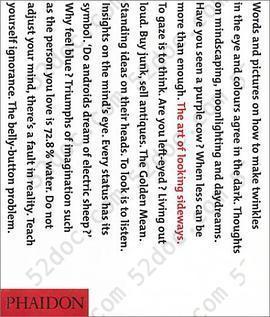注重体验与质量的电子书资源下载网站
分类于: 设计 其它
简介

The Art of Looking Sideways 豆 9.2分
资源最后更新于 2020-08-23 08:08:56
作者:Alan Fletcher
出版社:Phaidon Press
出版日期:2001-01
ISBN:9780714834498
文件格式: pdf
标签: 设计 艺术 design 平面设计 Art 平面 設計 美国
简介· · · · · ·
Describing himself as a "visual jackdaw", master designer Alan Fletcher has spent a lifetime collecting images, useless information, quotations and scraps that take his fancy. This work distils this collection into a quirky and entertaining feast for the eyes and the mind. Loosely arranged in 72 "chapters", the book explores the workings of the eye, the hand and the brain.
目录
【review】
Amazon.com Review
Alan Fletcher's The Art of Looking Sideways is an absolutely extraordinary and inexhaustible "guide to visual awareness," a virtually indescribable concoction of anecdotes, quotes, images, and bizarre facts that offers a wonderfully twisted vision of the chaos of modern life. Fletcher is a renowned designer and art director, and the joy of The Art of Looking Sideways lies in its beautiful design. Loosely arranged in 72 chapters with titles like "Colour," "Noise," "Chance," "Camouflage," and "Handedness," Fletcher's book, which he describes as "a journey without a destination," is "a collection of shards" that captures the sensory overload of a world that simply contains too much information. In one typical section, entitled "Civilization," the reader encounters six Polish flags designed to represent the world, a photograph of an anthropomorphic handbag, Buzz Aldrin's boot print on the moon, drawings of Stone Age pebbles, a painting of "Ireland--as seen from Wales," and a dizzying array of quotations and snippets of information, including the wise words of Marcus Aurelius, Stephen Jay, and Gandhi's comment, "Western civilization? I think it would be a good idea." Fletcher's mastery of design mixes type, space, fonts, alphabets, color, and layout combined with a "jackdaw" eye for the strange and profound to produce a stunning book that cannot be read, but only experienced. --Jerry Brotton, Amazon.co.uk
From Library Journal
This vast collection of assorted visual and verbal content is loosely strung together by the common thread of whatever captures the attention of celebrated designer Fletcher best known for his founding roles in the English design firm Fletcher Forbes Gill and the internationally recognized design group Pentagram. A table of contents (with headings such as "Learning," "Noise," and "Imagination") provides a loose structure for what is an otherwise unfettered stream-of-consciousness outpouring. In the author's own words, the book is "a journey without a destination." The book is tailor-made for those with short attention spans, since any given thought or narrative rarely runs for more than a spread. A worthy companion to other large, contemporary, designer-orchestrated explorations of visual culture, such as Bruce Mau's Life Style (Phaidon, 2000) or John Maeda's Maeda @ Media (Rizzoli, 2000), this book will delight anyone who enjoys unexpected visual and verbal play, cultural and historical observations and insights, and staggering amounts of trivia and anecdotes. Best suited for larger public libraries or libraries with extensive liberal arts, fine arts, or art history sections. Phil Hamlett, Turner & Associates, San Francisco
Amazon.com Review
Alan Fletcher's The Art of Looking Sideways is an absolutely extraordinary and inexhaustible "guide to visual awareness," a virtually indescribable concoction of anecdotes, quotes, images, and bizarre facts that offers a wonderfully twisted vision of the chaos of modern life. Fletcher is a renowned designer and art director, and the joy of The Art of Looking Sideways lies in its beautiful design. Loosely arranged in 72 chapters with titles like "Colour," "Noise," "Chance," "Camouflage," and "Handedness," Fletcher's book, which he describes as "a journey without a destination," is "a collection of shards" that captures the sensory overload of a world that simply contains too much information. In one typical section, entitled "Civilization," the reader encounters six Polish flags designed to represent the world, a photograph of an anthropomorphic handbag, Buzz Aldrin's boot print on the moon, drawings of Stone Age pebbles, a painting of "Ireland--as seen from Wales," and a dizzying array of quotations and snippets of information, including the wise words of Marcus Aurelius, Stephen Jay, and Gandhi's comment, "Western civilization? I think it would be a good idea." Fletcher's mastery of design mixes type, space, fonts, alphabets, color, and layout combined with a "jackdaw" eye for the strange and profound to produce a stunning book that cannot be read, but only experienced. --Jerry Brotton, Amazon.co.uk
From Library Journal
This vast collection of assorted visual and verbal content is loosely strung together by the common thread of whatever captures the attention of celebrated designer Fletcher best known for his founding roles in the English design firm Fletcher Forbes Gill and the internationally recognized design group Pentagram. A table of contents (with headings such as "Learning," "Noise," and "Imagination") provides a loose structure for what is an otherwise unfettered stream-of-consciousness outpouring. In the author's own words, the book is "a journey without a destination." The book is tailor-made for those with short attention spans, since any given thought or narrative rarely runs for more than a spread. A worthy companion to other large, contemporary, designer-orchestrated explorations of visual culture, such as Bruce Mau's Life Style (Phaidon, 2000) or John Maeda's Maeda @ Media (Rizzoli, 2000), this book will delight anyone who enjoys unexpected visual and verbal play, cultural and historical observations and insights, and staggering amounts of trivia and anecdotes. Best suited for larger public libraries or libraries with extensive liberal arts, fine arts, or art history sections. Phil Hamlett, Turner & Associates, San Francisco








